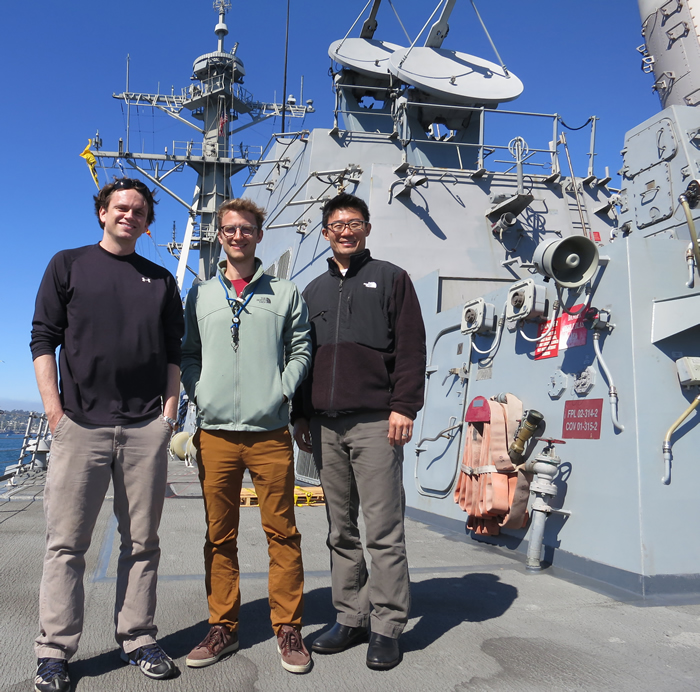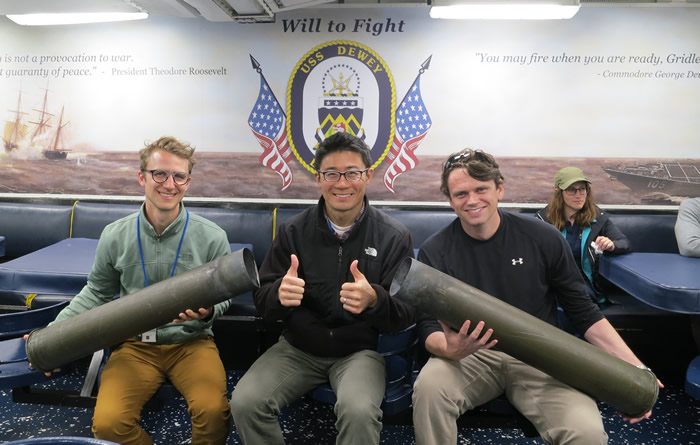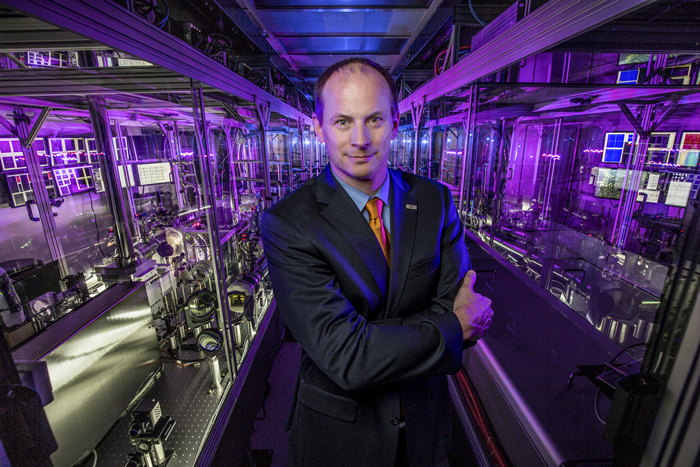NIF & PS People - 2017
November
Making Community Work for Kids—All Kids
Constantin Haefner Elected Fellow of the Optical Society
LLNL Sends First Scientists to Sea
NIF experimental laser physicist Reggie Drachenberg applies his expertise to optics and lasers for national defense. And after he and two fellow LLNL experts in optics, sonar and radar recently saw those technologies in action aboard a Navy destroyer, they discovered they may have even more potential technological contributions to make to U.S. defense capabilities.
That’s the advantage of putting Livermore Lab scientists out to sea, said Ken Bruner, the Laboratory’s deputy director for Defense Programs. Bruner serves as the Lab liaison to U.S. Pacific Command and its service components.
 LLNL scientists Ryan Goldhahn, left, Reggie Drachenberg, center, and Jason Chou spent three days aboard the USS Dewey guided missile destroyer as part of a Navy program to put experts in the field to become familiar with Department of Defense technology operations.
LLNL scientists Ryan Goldhahn, left, Reggie Drachenberg, center, and Jason Chou spent three days aboard the USS Dewey guided missile destroyer as part of a Navy program to put experts in the field to become familiar with Department of Defense technology operations. This fall Bruner recruited the three scientists as the first LLNL participants in a program called Scientists to Sea through the Navy’s Office of Naval Research (ONR): Drachenberg and Jason Chou of NIF, and Ryan Goldhahn of the Computational Engineering Division.
The trio took part in a three-day shipboard program with nine other researchers recruited from military, university, and other laboratories. While the Third Fleet has been operating the Navy program for more than a decade, officials say this is the first time Livermore scientists have participated.
Bruner coordinated the effort and hopes to send other researchers aboard for future voyages. “The bottom line is that anytime we can get our personnel out of the Lab into the real world, that’s a good thing,” he said.
Bruner is the former science and technology advisor for U.S. Pacific Command (USPACOM), one of nine joint combatant commands. USPACOM is responsible for military operations in the Indo-Asia-Pacific region that spans roughly half of Earth’s surface. His goals are to help LLNL researchers get familiar with the operational challenges faced by the Navy, and to help the Lab focus its research to improve national defense capabilities.
Drachenberg found it fascinating to live like a crewmember aboard a ship during exercises near San Diego Bay. One of the benefits of the program was that he and the other invited scientists had their security clearances transferred to the ship, so they could ask questions without limitations.
“It was not just asking what they do, but what they could use, and them talking to us about what we do that they could use now, (and) what could they use in the future,” said Drachenberg, a member of the DoD Technologies Fiber Laser Group in the NIF & Photon Science Directorate. “It was that exchange that I found valuable.”
Drachenberg was especially excited by the legacy of the San Diego-based guided missile destroyer they rode, the USS Dewey, named for the 19th century admiral, Commodore George Dewey. During the Spanish-American War, it was Dewey who uttered the famous battle cry, “You may fire when you are ready, Gridley.” Dewey later rose to the rank of Admiral of the Navy, a five-star rank, becoming the highest-ranking military officer in U.S. history.
 Drachenberg (left), Chou, and Goldhahn hold spent canisters from rounds fired by the USS Dewey’s mounted 5-inch gun during training exercises. The famous quote by the guided missile destroyer’s namesake is on the wall behind them.
Drachenberg (left), Chou, and Goldhahn hold spent canisters from rounds fired by the USS Dewey’s mounted 5-inch gun during training exercises. The famous quote by the guided missile destroyer’s namesake is on the wall behind them. NIF optical engineer Jason Chou found he was most successful by being proactive and networking during his deployment. “They wanted us to really be part of the shipboard experience,” said Chou, an optical engineer who works in technologies in radio-frequency photonics for defense applications. “It really took the whole three days to see the full operation and meet the people I needed to talk to.”
The shipboard detail was a success, in Chou’s view: “I came in without a lot of knowledge of a Navy destroyer, and this experience was eye-opening,” he said. “I have a much greater appreciation of the onboard sensor and weapons systems.”
Coordinating the Scientists at Sea program for the Navy was Jason Langton, science advisor to the commander of U.S. Third Fleet. While the program has been running for more than a decade, Langton said it generally has been serving military scientists and military-serving university researchers. Including a national lab was part of an expanded outreach effort.
The ONR shipboard program features scientific teams being hosted on vessels through the Third Fleet on a regular basis—between four and 13 researchers depending on the size of the craft. In 2016, Langton said, the program hosted more than 60 scientists aboard 10 Navy ships in the Third Fleet in the program’s cruisers, destroyers, amphibious assault ships, and aircraft carriers.
Researchers are chosen by nomination and must meet physical requirements. Trips last between three days and a week.
Building Rapport
The outcome, Langton said, includes building rapport that creates opportunities for long-term collaboration and invigorates passion for developing, deploying, and supporting innovative solutions. The Scientists to Sea program’s slogan is: Out of the office and out to sea.
Goldhahn found being aboard ship made communication easier, allowing him to talk directly to operators and see shipboard systems in action. Talking with the subject-matter experts he met helped him and the other LLNL researchers think more about what their research could do in the field on a practical level, said Goldhahn, a signal-processing engineer for Computational Engineering. “It was a great way for us to really see and understand their needs and make them aware of what the Lab capabilities are,” he said.
“It made us think about work that would have a real impact, so that we aren’t spinning our wheels on research questions that don’t matter in the real world.”
To prepare for the Scientists to Sea program, Bruner said he had been working for months with the commander of Pacific Fleet, who expressed interest in the Lab’s laser capabilities. The Navy outreach is among his ongoing efforts for the Lab in the defense arena, including the Air Force, said Bruner.
His efforts are aimed at understanding and coordinating Lab research and capabilities to fit with military and industry technologies: “Part of our job is defense cooperation,” he said, “and we have a unique position within the Department of Energy labs to fulfill that role.”
Constantin Haefner Elected Fellow of the Optical Society
Constantin Haefner, NIF & Photon Science program director for Advanced Photon Technologies, has been elected a fellow of the Optical Society of America (OSA). Haefner was recognized for “pioneering next generation, high-average-power petawatt laser systems enabling a new arena of applications and sustained advancement of state-of-the art technologies in large-scale, high intensity, peak-power laser systems.”
 Constantin Haefner led the development of the High-repetition-rate Advanced Petawatt Laser System (HAPLS) at LLNL. Credit: Jason Laurea
Constantin Haefner led the development of the High-repetition-rate Advanced Petawatt Laser System (HAPLS) at LLNL. Credit: Jason Laurea Haefner has more than 15 years of experience in developing and delivering energetic solid-state laser systems for laboratory high energy density (HED) physics research. He is an internationally respected expert for solid-state, high-average-power and high-peak-power laser development and systems engineering. As APT program director, he leads the research and development of advanced laser systems and technologies in support of national security missions and scientific and industrial applications.
Energetic solid-state laser systems are used in a variety of research areas, such as inertial confinement fusion (ICF), material physics, and high energy density physics. These lasers are used for delivering high laser pulse energies in the joule to megajoule (MJ) range in a very short time to a target, creating extremely high temperatures, pressures and fields comparable to the inside of the Sun.
Specifically, when interacting with matter, high-energy, high-peak-power laser systems generate high-brilliance x-ray sources or particle beams with unique characteristics—also known as secondary sources. These are utilized for diagnostics in HED and ICF, high-resolution imaging of dense objects, imaging of ultrafast processes in nature, and other applications. They are gaining increasing interest for potential industrial and medical applications such as non-destructive evaluation of objects, national-security missions, production of nuclear tracers relevant to medical imaging techniques, hadron cancer therapy, x-ray imaging at reduced dose for the patient, and many others.
The technical challenge for the design, construction, and operation of these lasers is enormous and is pushing laser technology to its limits. The program recently developed and constructed the High-repetition-rate Advanced Petawatt Laser System (HAPLS) for the European Extreme Light Infrastructure Facility in the Czech Republic. HAPLS is the first diode-pumped laser system in the world capable of running 10 hertz (10 pulses per second) and delivering petawatt pulses with a photon flux of 1.1 MJ per hour, opening the door to exploring real-world applications and precision science.
State-of-the-Art Technologies
Haefner joined LLNL in 2006 and focused his research on developing state-of-the-art short-pulse laser systems and technologies for the NIF & Photon Science directorate. He served as the chief scientist for the Advanced Radiographic Capability (ARC) multi-kilojoule laser system and developed the technologies for several ARC subsystems. Before joining LLNL, he was chief laser scientist at the Nevada Terawatt in Reno, Nevada, where he led the design and development of high-energy multi-terawatt laser systems for HED physics research.
Haefner received his diploma in physics in 1999 from the University of Constance, Germany, and his Ph.D. in laser physics in 2003 from the University of Heidelberg, Germany.
“It is a great honor to be elected a fellow of the Optical Society of America and to join such a prestigious group,” Haefner said. “It reflects great credit on the work we do at LLNL, and I have been fortunate to get to collaborate with a truly amazing, dedicated and incredibly talented team—instrumental in our pursuit of cutting-edge laser technology.”
Founded in 1916, OSA is the leading professional association in optics and photonics, home to accomplished science, engineering, and business leaders from all over the world. Fellow membership in OSA is limited to no more than 10 percent of the membership and is reserved for members who have served with distinction in the advancement of optics and photonics.




